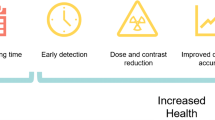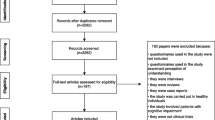Abstract
Purpose
To assess the current status of patient’s informed consent (PIC) management at radiological centres and the overall opinion of radiologist active members of the Italian Society of Medical Radiology (SIRM) about PIC dematerialisation through an online survey.
Methods and materials
All members were invited to join the survey as an initiative by the Imaging Informatics Chapter of SIRM. The survey consisted of 11 multiple-choice questions about participants’ demographics, current local modalities of PIC acquisition and storage, perceived advantages and disadvantages of PIC dematerialisation over conventional paper-based PIC, and overall opinion about PIC dematerialisation.
Results
A total of 1791 radiologists (amounting to 17.4% of active SIRM members for the year 2016) joined the survey. Perceived advantages of PIC dematerialisation were easier and faster PIC recovery (96.5%), safer storage and conservation (94.5%), and reduced costs (90.7%). Conversely, the need to create dedicated areas for PIC acquisition inside each radiological unit (64.0%) and to gain preliminary approval for the use of advanced digital signature tools from patients (51.8%) were seen as potential disadvantages. Overall, 94.5% of respondents had a positive opinion about PIC dematerialisation.
Conclusion
Radiologists were mostly favourable to PIC dematerialisation. However, concerns were raised that its practical implementation might face hurdles due to its complexity in current real life working conditions.


Similar content being viewed by others
References
Regulation (EU) No 910/2014 of the European Parliament and of the Council of 23 July 2014. http://eur-lex.europa.eu/legal-content/EN/TXT/?uri=uriserv%3AOJ.L_.2014.257.01.0073.01.ENG. Accessed 15 Feb 2019
Regulation (EU) 2016/679 of the European Parliament and of the Council of 27 April 2016. http://eur-lex.europa.eu/eli/reg/2016/679/oj. Accessed 15 Feb 2019
D.P.R. 445/2000—Testo unico sulla documentazione amministrativa. http://www.gazzettaufficiale.it/atto/serie_generale/caricaDettaglioAtto/originario?atto.dataPubblicazioneGazzetta=2001-02-20&atto.codiceRedazionale=001G0049&elenco30giorni=false (Italian law). Accessed 15 Feb 2019
D. lgs. 196/2003—Codice in materia di protezione dei dati personali. http://www.gazzettaufficiale.it/atto/serie_generale/caricaDettaglioAtto/originario?atto.dataPubblicazioneGazzetta=2003-07-29&atto.codiceRedazionale=003G0218 (Italian law). Accessed 15 Feb 2019
D. lgs. 82/2005—Codice dell’amministrazione digitale. http://www.gazzettaufficiale.it/atto/serie_generale/caricaDettaglioAtto/originario?atto.dataPubblicazioneGazzetta=2005-05-16&atto.codiceRedazionale=005G0104 (Italian law). Accessed 15 Feb 2019
D. lgs 235/2010—Modifiche ed integrazioni al decreto legislativo 7 Marzo 2005 n. 82. http://www.gazzettaufficiale.it/gunewsletter/dettaglio.jsp?service=1&datagu=2011-01-10&task=dettaglio&numgu=6&redaz=011G0002&tmstp=1294827516472 (Italian law). Accessed 15 Feb 2019
D.P.C.M. 22 febbraio 2013—Regole tecniche in materia di generazione, apposizione e verifica delle firme elettroniche avanzate, qualificate e digitali. http://www.gazzettaufficiale.it/eli/id/2013/05/21/13A04284/sg (Italian law). Accessed 15 Feb 2019
D.P.C.M. 03 dicembre 2013—Regole tecniche per il protocollo informatico. http://www.gazzettaufficiale.it/eli/id/2014/03/12/14A02099/sg (Italian law). Accessed 15 Feb 2019
D.P.C.M. 13 novembre 2014—Regole tecniche in materia di formazione, trasmissione, copia, duplicazione, riproduzione e validazione temporale dei documenti informatici, nonché di formazione e conservazione dei documenti informatici delle pubbliche amministrazioni. http://www.gazzettaufficiale.it/eli/id/2015/01/12/15A00107/sg (Italian law). Accessed 15 Feb 2019
D. lgs 179/2016—Modifiche ed integrazioni al codice dell’amministrazione digitale. http://www.gazzettaufficiale.it/eli/id/2016/09/13/16G00192/sg (Italian law). Accessed 15 Feb 2019
Schema di provvedimento in tema di riconoscimento biometrico e firma grafometrica [3132642]. http://www.garanteprivacy.it/web/guest/home/docweb/-/docweb-display/docweb/3132642 (Italian privacy regulation). Accessed 15 Feb 2019
Provvedimento generale prescrittivo in tema di biometria. http://www.garanteprivacy.it/web/guest/home/docweb/-/docweb-display/docweb/3556992 (Italian privacy regulation). Accessed 15 Feb 2019
Strickland NH (2000) PACS (picture archiving and communication systems): filmless radiology. Arch Dis Child 83(1):82–86
Mansoori B, Erhard KK, Sunshine JL (2012) Picture Archiving and Communication System (PACS) implementation, integration & benefits in an integrated health system. Acad Radiol 19(2):229–335
Faggioni L, Neri E, Cerri F, Turini F, Bartolozzi C (2011) Integrating image processing in PACS. Eur J Radiol 78(2):210–224
Ramella S, Mandoliti G, Trodella L, D’Angelillo RM (2015) The first survey on defensive medicine in radiation oncology. Radiol Med 120(5):421–429
Cenname G, D’Ambrosio I, Ajello C (2013) Teleradiology: case series and experience acquired in the military field. Radiol Med 118(4):688–699
Lindor RA, Kunneman M, Hanzel M, Schuur JD, Montori VM, Sadosty AT (2016) Liability and informed consent in the context of shared decision making. Acad Emerg Med 23(12):1428–1433
Nijhawan LP, Janodia MD, Muddukrishna BS, Bhat KM, Bairy KL, Udupa N, Musmade PB (2013) Informed consent: issues and challenges. J Adv Pharm Technol Res 4(3):134–440
Chalil Madathil K, Koikkara R, Obeid J, Greenstein JS, Sanderson IC, Fryar K, Moskowitz J, Gramopadhye AK (2013) An investigation of the efficacy of electronic consenting interfaces of research permissions management system in a hospital setting. Int J Med Inform 82(9):854–863
Schlechtweg PM, Hammon M, Giese D, Heberlein C, Uder M, Schwab SA (2014) iPad-based patient briefing for radiological examinations—a clinical trial. J Digit Imaging 27(4):479–485
Nishimura A, Carey J, Erwin PJ, Tilburt JC, Murad MH, McCormick JB (2013) Improving understanding in the research informed consent process: a systematic review of 54 interventions tested in randomized control trials. BMC Med Ethics 14:28
Sanderson IC, Obeid JS, Madathil KC, Gerken K, Fryar K, Rugg D, Alstad CE, Alexander R, Brady KT, Gramopadhye AK, Moskowitz J (2013) Managing clinical research permissions electronically: a novel approach to enhancing recruitment and managing consents. Clin Trials 10(4):604–611
Rowbotham MC, Astin J, Greene K, Cummings SR (2013) Interactive informed consent: randomized comparison with paper consents. PLoS ONE 8(3):e58603
Coppola F, Bibbolino C, Grassi R, Pierotti L, Silverio R, Lassandro F, Neri E, Regge D (2016) Results of an Italian survey on teleradiology. Radiol Med 121(8):652–659
Faggioni L, Coppola F, Ferrari R, Neri E, Regge D (2017) Usage of structured reporting in radiological practice: results from an Italian online survey. Eur Radiol 27(5):1934–1943
Flor N, Laghi A, Peri M, Cornalba G, Sardanelli F (2016) CT colonography: a survey of general practitioners’ knowledge and interest. Radiol Med 121(1):1–5
Laghi A, Neri E, Regge D (2015) Editorial on the European Society of Gastrointestinal Endoscopy (ESGE) and European Society of Gastrointestinal and Abdominal Radiology (ESGAR) guideline on clinical indications for CT colonography in the colorectal cancer diagnosis. Radiol Med 120(11):1021–1023
Pomara C, Pascale N, Maglietta F, Neri M, Riezzo I, Turillazzi E (2015) Use of contrast media in diagnostic imaging: medico-legal considerations. Radiol Med 120(9):802–809
Lee MC, Chuang KS, Hsu TC, Lee CD (2016) Enhancement of structured reporting—an integration reporting module with radiation dose collection supporting. J Med Syst 40(11):250
Lauretti DL, Neri E, Faggioni L, Paolicchi F, Caramella D, Bartolozzi C (2015) Automated contrast medium monitoring system for computed tomography–Intra-institutional audit. Comput Med Imaging Graph 46(Pt 2):209–218
Tait AR, Voepel-Lewis T, Levine R (2015) Using digital multimedia to improve parents’ and children’s understanding of clinical trials. Arch Dis Child 100(6):589–593
D. lgs 187/2000—Attuazione della direttiva 97/43/EURATOM in materia di protezione sanitaria delle persone contro i pericoli delle radiazioni ionizzanti connesse ad esposizioni mediche. http://www.gazzettaufficiale.it/atto/serie_generale/caricaDettaglioAtto/originario?atto.dataPubblicazioneGazzetta=2000-07-07&atto.codiceRedazionale=000G0236&elenco30giorni=false (Italian law). Accessed 15 Feb 2019
Haller G, Haller DM, Courvoisier DS, Lovis C (2009) Handheld vs. laptop computers for electronic data collection in clinical research: a crossover randomized trial. J Am Med Inform Assoc 16(5):651–659
Ranschaert ER, Binkhuysen FH (2013) European teleradiology now and in the future: results of an online survey. Insights Imaging 4(1):93–102
Funding
This study received no funding.
Author information
Authors and Affiliations
Corresponding author
Ethics declarations
Conflict of interest
The authors declare that they have no conflict of interest.
Ethical approval
This article does not contain any studies with human participants or animals performed by any of the authors.
Additional information
Publisher's Note
Springer Nature remains neutral with regard to jurisdictional claims in published maps and institutional affiliations.
Appendix
Appendix
-
Q1) Which Italian region do you work in?
-
Q2) What is your age?
-
Q3) What is the site of your main professional activity?
-
Q4) What is your professional degree?
-
Q5) How would you qualify your computer skills?
-
Q6) Who developed the PIC form that you currently use? (multiple answers allowed)
-
Q7) Can PIC be revoked by the patient before the procedure?
-
Q8) How is PIC usually stored? (multiple answers allowed)
-
Q9) The main goal of PIC dematerialisation is to develop a digital document with full legal value that will ultimately replace conventional, paper-based PIC. This process requires patients to approve the acquisition of advanced electronic signature, and radiologists to use digital signature systems as well (e.g. smart card, token, etc.) to countersign PIC. In your opinion, what are the main advantages of PIC dematerialisation?
-
Q10) In your opinion, what are the main disadvantages of PIC dematerialisation?
-
Q11) Dematerialisation is a process on which the Italian government has invested heavily. “Digital Italy” would allow savings around 43 billion euro per year. Considering the overall issues involving your professional activity, do you believe this process would be needed?
Rights and permissions
About this article
Cite this article
Coppola, F., Faggioni, L., Grassi, R. et al. Dematerialisation of patient’s informed consent in radiology: insights on current status and radiologists’ opinion from an Italian online survey. Radiol med 124, 846–853 (2019). https://doi.org/10.1007/s11547-019-01033-9
Received:
Accepted:
Published:
Issue Date:
DOI: https://doi.org/10.1007/s11547-019-01033-9




